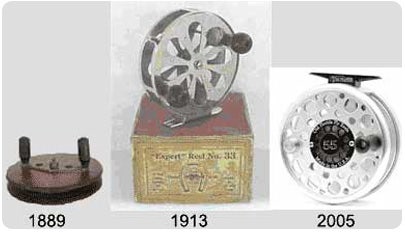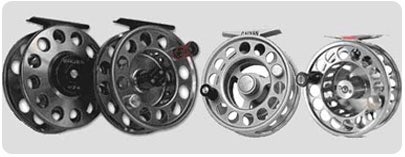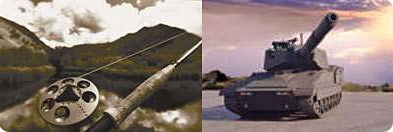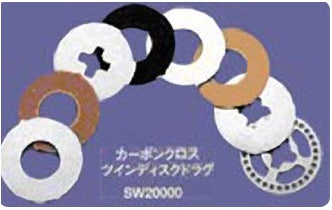
Waterworks began to develop product ideas and explore the fly fishing market in 1995. After a long weekend with dead fish in the bathtub, designer Mark Farris emerged with a tool capable of reducing fish mortality by eliminating netting and handling. They called this the Ketchum Release, a play on the name of the home town of Ketchum, Idaho. It was an immediate success.
Following the Ketchum Release and several other accessory ideas, they quickly turned our attention to fly reels. They could see that fly reels were poorly designed. Reels were too complicated; they were using too many parts; drag systems and other running parts were exposed to the elements; reels were too heavy. They began with a blank sheet of paper, and undertook a total re-think of the fly reel.
The Waterworks becomes the Waterworks-Lamson: 1999
Late in 1998, Waterworks acquired Lamson from Sage Manufacturing. Lamson reels had established a well-deserved reputation in the 1980’s and 90’s for being the first fully machined quality reel at an affordable price. The “LP” design became the standard of it’s time and sold for a very reasonable price of $200.
With the acquisition of the Lamson trademark, and the design work for Sage under our belt, they were ready to bring their own line of reels to market.
Designing a Reel: Let’s Start With Design Objectives
When Waterworks set out to design their own reels, they started by evaluating not just the reel, but the rod/reel system. As they discussed, observed and evaluated rod design at the world’s leading rod manufacturers, they quickly came to the conclusion that reels were too heavy. They needed to lighten reels in order to keep pace with the ever-lighter rods and to eliminate the negative impact that a reel has on a rod’s casting performance. Call this their first objective: reduce physical weight.
Another objective was to simplify the design of a reel. With any mechanical device, simplicity is a virtue. They saw reels with 80+ parts. It is easy to make something with too many parts; it’s hard to make something work with fewer parts. Simplicity means that there is less that can go wrong, can result in the virtue of less physical weight, and moreover, often becomes the catalyst for an elegant design solution.
A third objective was to optimize large arbor benefit. The world is full of reels that call themselves “large arbor” but whose bark in this regard is louder than their bite. Call these reels mid-arbor. Waterworks believe in the virtues of large arbor: faster retrieve rate, constant drag tension and elimination of coil memory. So they set out to maximize the benefits.
Wateroworks felt that they could bring a better reel to market by using superior materials and processes. They looked at fly reels and saw materials being used that were cutting edge at the time of Jesus. Much advancement has been made in the past 2,000 years, even the past 10 years, that were not being applied to fly reels to make them perform better.
Finally, they set out to design the world’s best drag system. This meant zero start-up inertia. It meant silk-smooth through the entire torque range. It meant top-end torque sufficient to stop what you catch. It meant that the drag would perform exactly the same under all conditions that one met in real life: water, sand, dirt. It meant that you shouldn’t have to think about your drag, ever. No cleaning or lubrication required.
And so Waterworks objectives were clear:
- Reduce physical weight
- Achieve mechanical simplicity
- Maximize large arbor benefit
- Utilize superior materials
- Create the world’s best drag system

Rods had gotten lighter. Reels had not. How much did a 5-wt. rod weigh ten years ago? Five ounces? Five and a half ounces? How much did a reel weigh? About the same.
Now rods weigh almost 50% less than they did ten years ago. When they began this project, trout reels still weighed five ounces and more. Reels had become the 350-pound passenger in a finely tuned Lotus. It became time to get a lighter passenger.
How do you reduce the weight of the reel? There were a number possible approaches to choose from: reduce overall size; reduce material usage; use lighter materials; create a lighter structural format; reduce the weight and number of components.
Obviously, to build a large arbor reel, the first option was not a practical consideration. But each other directive held promise.
Waterworks reduced material usage by careful and precise engineering and machining, leaving material only where it provided structural strength, carving every gram from non-critical areas. They made bold (and expensive) material choices employing titanium where other manufacturers used steel, polymers instead of wood and cork.
They invented a structure that would free the reel from the bulkiness of traditional designs. Key to this process was a drag system that, unlike a disc, wouldn’t dictate a particular and restrictive geometry for the reel. The development of the conical drag was therefore integral to building what would seem to be an engineering paradox: Bigger yet lighter. Lastly, they shaved grams off each individual component through testing, evaluation, re-design and refinement.
Design Objective: Achieve Mechanical Simplicity

Tear apart a reel today, and be prepared for the horror of finding 80 to 100 parts. Thingamajigs connecting the whatsit to the whoseyourdaddy. They can look like an eighth grade science project. Sporting a whopping 23 parts, the ULA aptly demonstrates the adage of form following function. And every once in a while the quest for simple design can result in something unexpected: A form that becomes so succinct that it may approach the compact beauty of a poem.
Two examples to illustrate their approach to simplicity. Imagine the typical fly reel counterbalance; a slug of metal and a screw opposite the handle. Take a look at the ULA spool face above. Where’s the counterbalance? The asymmetry of the spoke provides the mass to balance the handle. Two parts down, but what’s more, this form becomes one of the signature aesthetic elements of the reel.
Another example of mechanical simplicity is the spool latching mechanism. On other reels, the latching mechanism involves a button or a lever that activates springs & plates that grab and hold the spool onto the frame. These represent ten to fifteen parts that create an opening for contaminants to enter the running gear of the reel, and ten to fifteen parts that can fail in time. All of the Waterworks reels use a simple but effective o-ring lock that serves two purposes: to lock the spool to the frame and to seal the drag chamber. This lock is achieved using no extra parts. The spindle flair passes over an o-ring at the entrance to the drag chamber and then locks into a groove machined into the drag cap. Waterworks eliminate parts, eliminate liabilities, serve two functions, create virtues. Simple.
Design Objective: Maximize Large Arbor Benefit
 History – Traditional Arbor Reels
History – Traditional Arbor Reels
There are those who minimize the importance of a reel by saying “it just holds line”. But how a reel stores line has everything to do with performance. Line stored in deep, narrow reels will develop coil memory; drag tension will increase as line is pulled from the spool on long runs; and line retrieval is an exercise in frustration. Traditional storage formats can be seen in the reels below. Can you get any narrower and deeper than the wooden example from 1889? But look at the advancements made in design by 1913: reels were carved from metal, they had standard reel feet, they had counterbalances smaller than your fist, they even came in a box! But they still had deep, narrow storage for line. And just look at the advancements in small arbor designs in the 98 years since 1913!
The traditional small-arbor storage format, with its unavoidable liabilities, was the state of the art from the beginning of time until the mid-1990’s.
First Generation “Large Arbor” Reels vs. True Large Arbor Reels
 In the early 1990’s the first generation of “large arbor” reels were introduced. While representing an advancement over traditional storage formats, and solving some of the maintenance and drag problems associated with earlier reels, these reels actually offered only minimal improvement over traditional arbor reels. For all practical purposes they can be thought of as “mid-arbor” reels, and these formats are still the most common found in the market.
In the early 1990’s the first generation of “large arbor” reels were introduced. While representing an advancement over traditional storage formats, and solving some of the maintenance and drag problems associated with earlier reels, these reels actually offered only minimal improvement over traditional arbor reels. For all practical purposes they can be thought of as “mid-arbor” reels, and these formats are still the most common found in the market.
A true large arbor format drastically increases the width of the spool and can therefore increase the arbor diameter significantly without reducing line and backing capacity. Ideally it must do these things without being heavier. If so, then the result is a maximization of the benefits of large arbor design.
Design Objective: Utilize Superior Materials

Titanium (Ti) is the 22nd element in the Periodic Table. It may not look like much when it is in raw pellet form, but Titanium is very impressive when machined into reel parts. Waterworks use titanium where applicable in the ULA reels. Stronger than stainless, virtually inert, and weighing about 35% less, it is a costly and worthy alternative. In instances where stainless is more appropriate, we chose exotic, high strength “super alloys” like 17-4 PH rather than the typical, far weaker 302 or 303 found in other reels.
 The Waterworks reels and this tank have more in common than you might imagine. Both use a form of anodizing that is very hard and exceptionally wear resistant: type 3 hard anodize.
The Waterworks reels and this tank have more in common than you might imagine. Both use a form of anodizing that is very hard and exceptionally wear resistant: type 3 hard anodize.
Anodizing is an electrolytic process for producing controlled aluminum oxide films on aluminum. Oxide forms naturally on untreated aluminum but the anodizing process produces a coating which is uniform, harder and more dense than natural oxidation.
Virtually every other reel uses a decorative finish called type 2 anodize. Type 2 allows for the use of a variety of colors and brightness, but it is a thin and easily penetrated surface. Type 3 hard anodize surfaces are thicker, with surface hardness and abrasion resistance as their primary characteristic. Type 3 finishes are produced using special anodizing conditions that limit the use of dye. Since type 3 anodizing produces far superior protection, why are they the only reel to use type 3 hard finishes? Again, we can only guess that it’s because the process is expensive, it’s demanding, and it limits color choice. It’s not the easier path. But it’s the path to better results.
Design Objective: Create the World’s Best Drag System
 Why are virtually all drag systems based on rotating disks? Because it’s easy. Call up the company that makes the disks shown on the left. Want cork? Want plastic? Place your order and it shows up in three days. But there are a few problems with this common approach.
Why are virtually all drag systems based on rotating disks? Because it’s easy. Call up the company that makes the disks shown on the left. Want cork? Want plastic? Place your order and it shows up in three days. But there are a few problems with this common approach.
The first problem is associated with the disk shape itself. A typical approach is to use two disks (one stationary, one rotates). But the disks need to be large in order to have the surface area required to generate stopping power. Once a disk is large it cannot be sealed from the elements, and this exposure brings with it a long list of other problems.
To address this problem, they reshaped the traditional disk drag into two mated cones. By doing so, they were able to take advantage of a large surface area for torque, but they'd reduce the overall diameter of the system so it could be fitted into a sealed chamber. The male cone is precisely machined to mate with a female cone; the male rotates while the female remains stationary.
The male conical element is a polymer alloy with an extremely low co-efficient of friction, and the female element is a
 Teflon impregnated metallic surface. The male cone has a very low co-efficient of thermal conductivity, meaning it conducts heat very slowly. The female cone, which is part of the frame, conducts heat very quickly. Thus, when heat is product by friction it is “wicked” off the male cone and out through the frame. The polymer alloy and Teflon/metal cones run without any oil or grease; thus no maintenance is required to keep the drag system performing at it’s best. And because the drag parts require no lubrication, don’t wear, and are fully sealed, the fisherman will never experience a change in performance and will never be burdened with cleaning, lubricating or maintaining the drag in any way.
Teflon impregnated metallic surface. The male cone has a very low co-efficient of thermal conductivity, meaning it conducts heat very slowly. The female cone, which is part of the frame, conducts heat very quickly. Thus, when heat is product by friction it is “wicked” off the male cone and out through the frame. The polymer alloy and Teflon/metal cones run without any oil or grease; thus no maintenance is required to keep the drag system performing at it’s best. And because the drag parts require no lubrication, don’t wear, and are fully sealed, the fisherman will never experience a change in performance and will never be burdened with cleaning, lubricating or maintaining the drag in any way.
Differences Among the Waterworks-Lamson Reel Models
The Waterworks Vanquish and Waterworks ULA designs represent our undiluted design vision. No compromises were made in materials or design. The result is lightweight, high performance and beautiful. But they don’t come cheap. The Lamson Litespeed was designed to bring as many of the V Series and ULA performance benefits to a more affordable reel. We achieved this by changing the structure and moving from titanium to stainless, yet were able to keep all other features of the ULA. Lamson Velocity brings this world-class drag to a large arbor reel at only $250. Lamson Guru, by machining a simpler form and foregoing expensive finishes, brings machined technology and a $400+ drag to the $175 price point. And Lamson Konic with it’s hybrid of machined conical drag and pressure-cast case and large arbor spool, brings superior performance to the low-$100′s. Each of the Waterworks-Lamson fly reels were designed to achieve this one goal: to offer superior performance and value at its respective price point.

To read more about Waterworks-Lamson Fly Reels click here
